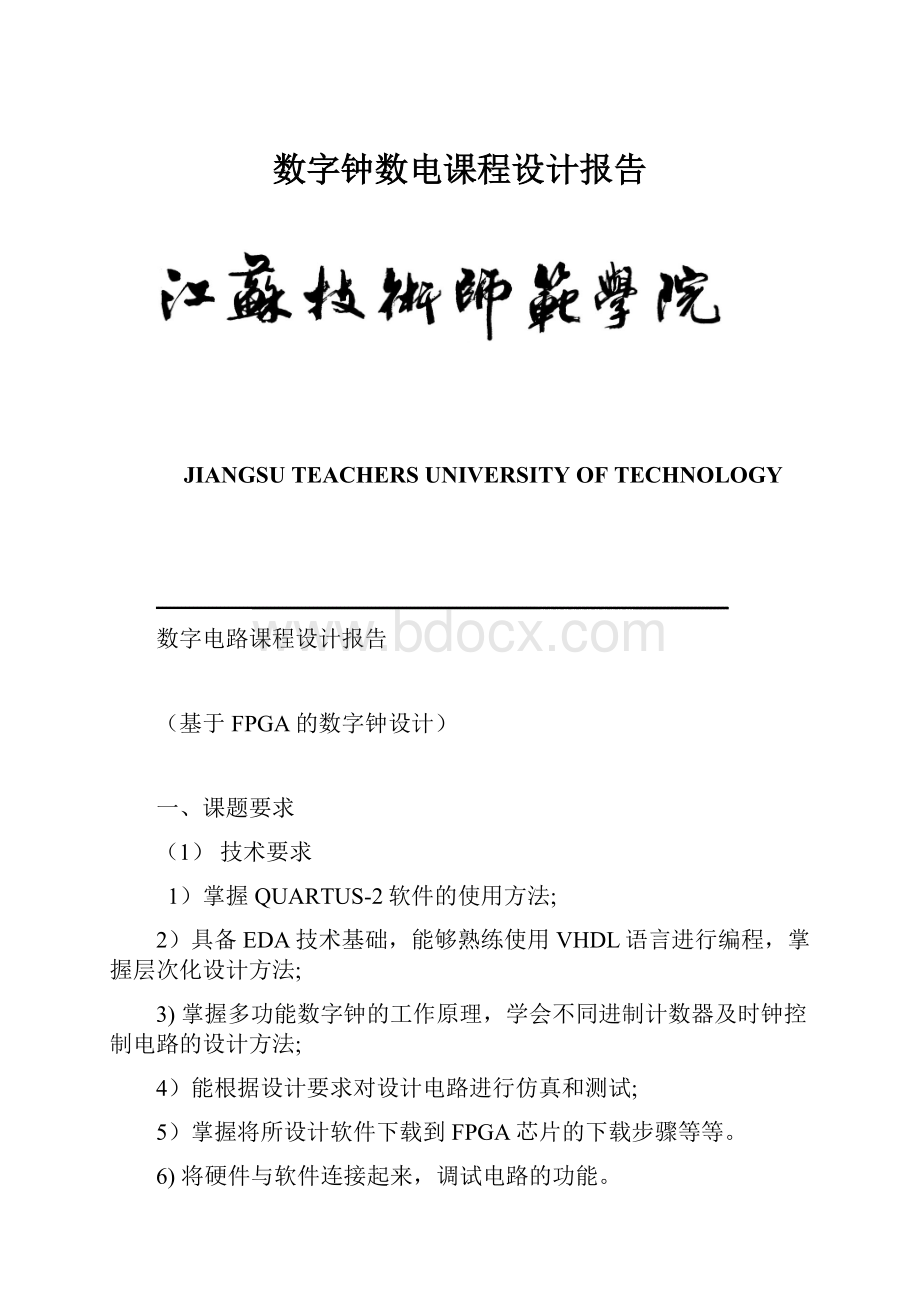数字钟数电课程设计报告.docx
《数字钟数电课程设计报告.docx》由会员分享,可在线阅读,更多相关《数字钟数电课程设计报告.docx(25页珍藏版)》请在冰豆网上搜索。

数字钟数电课程设计报告
JIANGSUTEACHERSUNIVERSITYOFTECHNOLOGY
数字电路课程设计报告
(基于FPGA的数字钟设计)
一、课题要求
(1)技术要求
1)掌握QUARTUS-2软件的使用方法;
2)具备EDA技术基础,能够熟练使用VHDL语言进行编程,掌握层次化设计方法;
3)掌握多功能数字钟的工作原理,学会不同进制计数器及时钟控制电路的设计方法;
4)能根据设计要求对设计电路进行仿真和测试;
5)掌握将所设计软件下载到FPGA芯片的下载步骤等等。
6)将硬件与软件连接起来,调试电路的功能。
(2)功能要求
基本功能:
能进行正常的时、分、秒计时功能,分别由6个数码管显示24小时,60分钟,60秒钟的计数器显示。
附加功能:
1)能利用硬件部分按键实现“校时”“校分”“清零”功能;
2)能利用蜂鸣器做整点报时:
当计时到达59’55’’时开始报时,在55’’56’’57’’58’’59’’时鸣叫,共鸣叫5秒钟;
3)定时闹铃:
本设计中设置的是在六点半时进行闹钟功能,鸣叫时间为一分钟。
(3)本人工作
本人主要负责硬件安装及焊接部分!
二、设计方案
1)数字钟电路的原理框图详见末页图(a)
2)数字钟设计方案
采用同步电路,总线结构。
时钟信号分别加到各个模块,各个模块相对独立,模块间连线简单,易于扩展。
振荡器和分频器产生稳定的校时信号和计时信号。
对“秒”计时信号进行60进制计数,形成“分”计时信号和秒计数值;再对“分”计时信号进行60进制计数,形成“时”计时信号和分计数值;进一步对“时”计时信号进行24进制计数得到时计数值。
秒计数值、分计数值和时计数值译码显示时间。
3)数字钟的工作原理
数字电子钟由振荡器、分频器计数器、译码显示、报时等电路组成。
振荡器产生稳定的高频脉冲信号,作为数字钟的时间基准,然后经过分频器输出标准秒脉冲。
秒计数器满60后向分计数器进位,分计数器满60后向小时计数器进位,小时计数器按照“24翻1”规律计数。
计满后各计数器清零,重新计数。
计数器的输出分别经译码器送数码管显示,计时出现误差时,可以用校时电路“校时”“校分”“清零”。
秒脉冲可以通过分频电路得到。
通过报时设计模块可以实现整点报时及定时闹铃,译码显示由七段译码器完成,显示由数码管构成,采用的是动态显示方式。
数码管动态显示:
动态扫描电路将计数器输出的8421BGD码转换为数码管需要的逻辑状态,并且输出数码管的片选信号和为选信号。
所谓动态扫描显示方式是在显示某一位LED显示块的数据的时候,让其它位不显示,然后再显示下一位的数据。
只要保证每一位显示的时间间隔不要太大,利用人眼的视觉暂留的现象,就可以造成各位数据同时显示的假象。
一般每一位的显示时间为1~10ms。
三、单元电路设计及仿真结果与分析
(1)分频模块(fenpin)
1)程序:
libraryieee;
useieee.std_logic_1164.all;
entityfenpinis
port(clk6:
instd_logic;
q1000,q5,q1:
outstd_logic);
endfenpin;
architectureccc_arcoffenpinis
signalx:
std_logic;
begin
process(clk6)
variablecnt:
integerrange0to24999;
begin
ifclk6'eventandclk6='1'then
ifcnt<24999then
cnt:
=cnt+1;
else
cnt:
=0;
x<=notx;
endif;
endif;
endprocess;
q1000<=x;
process(x)
variablecnt2:
integerrange0to999;
variabley:
std_logic;
begin
ifx'eventandx='1'then
ifcnt2<999then
cnt2:
=cnt2+1;
q1<='0';
else
cnt2:
=0;
q1<='1';
endif;
endif;
ifx'eventandx='1'then
y:
=noty;
endif;
q5<=y;
endprocess;
endccc_arc;
2)仿真波形:
(2)秒模块(second)
1)程序:
libraryieee;
useieee.std_logic_1164.all;
useieee.std_logic_unsigned.all;
entitysecondis
port(clk1,en1:
instd_logic;
qa:
outstd_logic_vector(3downto0);
co1:
outstd_logic;
qb:
outstd_logic_vector(3downto0));
endsecond;
architectureccofsecondis
signalcout2,cout1:
std_logic_vector(3downto0);
signalmm:
std_logic;
begin
process(clk1,en1)
begin
ifen1='1'then
cout2<="0000";cout1<="0000";
elsif(clk1'eventandclk1='1')then
if(cout2=5andcout1=8)thencout2<=cout2;cout1<=cout1+1;mm<='1';
elsif(cout2=5andcout1=9)thencout2<="0000";cout1<="0000";mm<='0';
elseif(cout1=9)thencout2<=cout2+1;cout1<="0000";mm<='0';
elsecout2<=cout2;cout1<=cout1+1;mm<='0';
endif;
endif;
endif;
endprocess;
co1<=mm;
qa<=cout2;
qb<=cout1;
endcc;
2)仿真波形:
(3)分模块(minute)
1)程序:
libraryieee;
useieee.std_logic_1164.all;
useieee.std_logic_unsigned.all;
entityminuteis
port(clk2,en2:
instd_logic;
qc:
outstd_logic_vector(3downto0);
co2:
outstd_logic;
qd:
outstd_logic_vector(3downto0));
endminute;
architecturebbofminuteis
signalcout2,cout1:
std_logic_vector(3downto0);
signalcc:
std_logic;
begin
process(clk2,en2)
begin
ifen2='1'then
if(clk2'eventandclk2='1')then
if(cout2=5andcout1=8)thencout2<=cout2;cout1<=cout1+1;cc<='1';
elsif(cout2=5andcout1=9)thencout2<="0000";cout1<="0000";cc<='0';
elseif(cout1=9)thencout2<=cout2+1;cout1<="0000";cc<='0';
elsecout2<=cout2;cout1<=cout1+1;cc<='0';
endif;
endif;
endif;
endif;
endprocess;
co2<=cc;
qc<=cout2;
qd<=cout1;
endbb
2)仿真波形:
(4)时模块(hour)
1)程序:
libraryieee;
useieee.std_logic_1164.all;
useieee.std_logic_unsigned.all;
entityhouris
port(clk3,en3:
instd_logic;
qe:
outstd_logic_vector(3downto0);
qf:
outstd_logic_vector(3downto0));
endhour;
architectureaaofhouris
signalcout2,cout1:
std_logic_vector(3downto0);
begin
process(clk3,en3)
begin
ifen3='1'then
if(clk3'eventandclk3='1')then
if(cout2=2andcout1=3)thencout2<="0000";cout1<="0000";
elseif(cout1=9)thencout2<=cout2+1;cout1<="0000";
elsecout2<=cout2;cout1<=cout1+1;
endif;
endif;
endif;
endif;
endprocess;
qe<=cout2;
qf<=cout1;
endaa;
2)仿真波形:
(5)数码显示驱动模块
1)程序:
libraryieee;
useieee.std_logic_1164.all;
useieee.std_logic_unsigned.all;
entityhhhis
port(n1,n2,n3,n4,n5,n6:
instd_logic_vector(3downto0);
a:
instd_logic_vector(2downto0);
qqq:
outstd_logic_vector(3downto0));
endhhh;
architectureddofhhhis
begin
withaselect
qqq<=n1when"000",
n2when"001",
n3when"010",
n4when"011",
n5when"100",
n6when"101",
"0000"whenothers;
enddd;
2)仿真波形:
(6)片选模块(sell)
1)程序:
libraryieee;
useieee.std_logic_1164.all;
useieee.std_logic_unsigned.all;
entitygggis
port(m:
instd_logic_vector(2downto0);
b:
outstd_logic_vector(5downto0));
endggg;
architectureeeofgggis
begin
withmselect
b<="100000"when"000",
"010000"when"001",
"001000"when"010",
"000100"when"011",
"000010"when"100",
"000001"when"101",
"000000"whenothers;
endee;
2)仿真波形:
(7)译码显示模块(display)
1)程序:
libraryieee;
useieee.std_logic_1164.all;
useieee.std_logic_unsigned.all;
entitydecoderis
port(x:
instd_logic_vector(3downto0);
y:
outstd_logic_vector(6downto0));
enddecoder;
architectureoneofdecoderis
begin
withxselect
y<="1111110"when"0000",
"0110000"when"0001",
"1101101"when"0010",
"1111001"when"0011",
"0110011"when"0100",
"1011011"when"0101",
"1011111"when"0110",
"1110000"when"0111",
"1111111"when"1000",
"1111011"when"1001",
"0000000"whenothers;
endone;
2)仿真波形:
(8)报时模块(alart)
1)程序:
libraryieee;
useieee.std_logic_1164.all;
entitysstis
port(h1,h0,m1,m0,s1,s0:
instd_logic_vector(3downto0);
clk4:
instd_logic;
q500:
outstd_logic);
endsst;
architecturesssofsstis
begin
process(clk4,m1,m0,s1,s0)
begin
if(clk4'eventandclk4='1')then
if((h1="0000"andh0="0110"andm1="0011"andm0="0000")
or(m1="0101"andm0="1001"ands1="0101"and
(s0="0101"ors0="0110"ors0="0111"ors0="1000"ors0="1001")))then
q500<='1';
else
q500<='0';
endif;
endif;
endprocess;
endsss;
2)仿真波形:
(9)六进制计数器模块(cnt6)
1)程序:
libraryieee;
useieee.std_logic_1164.all;
useieee.std_logic_unsigned.all;
entitycnt6is
port(clk5:
instd_logic;
n:
outstd_logic_vector(2downto0));
endcnt6;
architecturebehavofcnt6is
signalq1:
std_logic_vector(2downto0);
begin
process(clk5)
begin
ifclk5'eventandclk5='1'then
ifq1<5thenq1<=q1+1;
elseq1<=(others=>'0');
endif;
endif;
endprocess;
n<=q1;
endbehav;
2)仿真波形:
(10)两输入与模块(and2a)
1)程序:
libraryieee;
useieee.std_logic_1164.all;
entityandais
port(a1,b1:
instd_logic;
y:
outstd_logic);
endanda;
architectureanofandais
begin
y<=a1andb1;
endan;
2)仿真波形:
(11)两输入或模块(or2a)
1)程序:
libraryieee;
useieee.std_logic_1164.all;
entityor_1is
port(a1,b1:
instd_logic;
y:
outstd_logic);
endor_1;
architectureooofor_1is
begin
y<=a1orb1;
endoo;
2)仿真波形:
四、顶层电路设计及仿真结果与分析
1)程序:
libraryieee;
useieee.std_logic_1164.all;
entitydigital_clockis
port(clk,sa,sb,sc:
instd_logic;
q1:
outstd_logic;
r:
outstd_logic_vector(5downto0);
q0:
outstd_logic_vector(6downto0));
enddigital_clock;
architecturemainofdigital_clockis
componentanda
port(a1,b1:
instd_logic;
y:
outstd_logic);
endcomponent;
componentor_1
port(a1,b1:
instd_logic;
y:
outstd_logic);
endcomponent;
componentfenpin
port(clk6:
instd_logic;
q1000,q1,q5:
outstd_logic);
endcomponent;
componenthour
port(clk3,en3:
instd_logic;
qe:
outstd_logic_vector(3downto0);
qf:
outstd_logic_vector(3downto0));
endcomponent;
componentminute
port(clk2,en2:
instd_logic;
qc:
outstd_logic_vector(3downto0);
co2:
outstd_logic;
qd:
outstd_logic_vector(3downto0));
endcomponent;
componentsecond
port(clk1,en1:
instd_logic;
qa:
outstd_logic_vector(3downto0);
co1:
outstd_logic;
qb:
outstd_logic_vector(3downto0));
endcomponent;
componentsstis
port(h1,h0,m1,m0,s1,s0:
instd_logic_vector(3downto0);
clk4:
instd_logic;
q500:
outstd_logic);
endcomponent;
componenthhh
port(n1,n2,n3,n4,n5,n6:
instd_logic_vector(3downto0);
a:
instd_logic_vector(2downto0);
qqq:
outstd_logic_vector(3downto0));
endcomponent;
componentggg
port(m:
instd_logic_vector(2downto0);
b:
outstd_logic_vector(5downto0));
endcomponent;
componentcnt6is
port(clk5:
instd_logic;
n:
outstd_logic_vector(2downto0));
endcomponent;
componentdecoder
port(x:
instd_logic_vector(3downto0);
y:
outstd_logic_vector(6downto0));
endcomponent;
signala,b,c,h,i,j,z:
std_logic;
signalk,l,e,f,u,v,t:
std_logic_vector(3downto0);
signals:
std_logic_vector(2downto0);
begin
u1:
fenpinportmap(clk6=>clk,q1=>h,q1000=>z);
u2:
secondportmap(clk1=>h,en1=>sc,qa=>k,qb=>l,co1=>I);
u0:
or_1portmap(a1=>i,b1=>sb,y=>a);
u3:
minuteportmap(clk2=>h,en2=>a,qc=>e,qd=>f,co2=>j);
u30:
andaportmap(a1=>i,b1=>j,y=>b);
u31:
or_1portmap(a1=>b,b1=>sa,y=>c);
u4:
hourportmap(clk3=>h,en3=>c,qe=>u,qf=>v);
u5:
sstportmap(h1=>u,h0=>v,m1=>e,m0=>f,s1=>k,s0=>l,clk4=>h,q500=>q1);
u6:
hhhportmap(n1=>k,n2=>l,n3=>e,n4=>f,n5=>u,n6=>v,qqq=>t,a=>s);
u7:
gggportmap(b=>r,m=>s);
u8:
cnt6portmap(n=>s,clk5=>z);
u9:
decoderportmap(x=>t,y=>q0);
endarchitecturemain;
2)仿真波形:
五、硬件电路设计与安装电路
(1)按照电路功能设计好硬件部分安装图(电路安装图详见末页图b);
(2)根据电路板的大小以及所有的元器件,大致决定好各元器件的分布情况。
注:
布线不能有交叉线,且要注意工艺问题即布线要讲究横平竖直原则。
(3)先把数码管底座插到板子上,把各个数码管之间相连接起来需要的导线准备好,用胶带贴在板子上固定好;然后再逐步增加元器件,用同样的方法布好线固定好。
注:
必须清楚共阴极数码管的各引脚以及三极管的引脚。
(4)接下来就是焊接部分,把导线引脚都焊接到板子上。
也可以在布线的过程中排好一部分线就焊接一部分,分步来。
注:
我的烙铁功率(30W)较大,焊接过程中必须快、狠、准,烙铁与焊盘接触时间不能太长否则焊盘容易脱落。
(5)由于我们需要六个数码管,相对来说,线路比较复杂,布线比较容易有交叉线,所以,不好布线的部分可以充分利用杜邦线的作用,这样电路板布局比较清楚,导线分布也比较美观。
(6)电路焊接好后,对照电路图检查一下电路。
确定电路无误后才能连接芯片调试功能。
注:
硬件电路和芯片连接时要仔细,注意程序